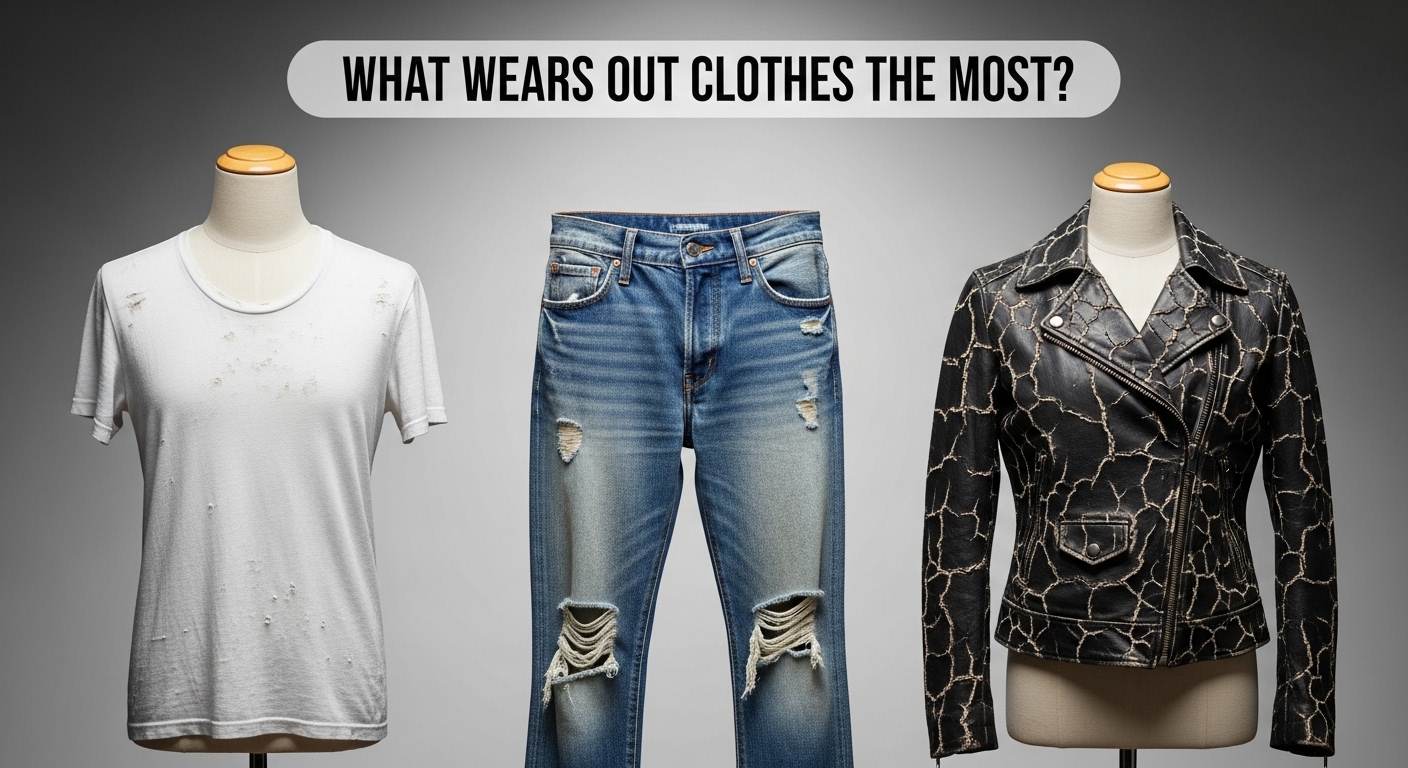
I can’t tell you how many times I’ve pulled a favorite shirt from my closet only to notice it looked older than me in the mirror. It wasn’t that I didn’t love it enough—I wore it often, cared for it, and yet somehow, it still lost its charm. That got me thinking: what actually wears out clothes the most?
The truth is, it isn’t just one thing. Washing machines, dryers, friction from daily wear, sunlight, even the way we store our clothes all play a part in breaking them down. And the surprising part? Most of the damage doesn’t even happen while we’re wearing them—it happens in our laundry routine.
In this guide, I’ll walk you through the hidden reasons clothes age faster than they should and share what I’ve learned about keeping them looking fresh for longer.
Does washing really wear out clothes faster?
Yes, frequent washing is the leading cause of clothes wearing out quickly. Water, detergents, and the physical movement of fabric inside a washing machine weaken fibers with each cycle.
Clothing fibers aren’t invincible; every time they rub against each other during washing, tiny bits break off. Over time, this leads to thinning fabric, faded colors, and pilling. A study by the International Journal of Consumer Studies found that repeated washing reduced fabric strength by up to 40% after only 20 cycles. That’s a shocking number when you realize how often we launder our everyday clothes.
Detergents also play a role. Harsh chemicals strip away natural oils from fibers, making them brittle. This is particularly true for delicate fabrics like silk and wool, which are sensitive to both temperature and chemical composition. Hot water intensifies the problem by loosening dye bonds, which explains why bright clothes fade faster in high-temperature washes.
The best way to reduce washing damage is to launder less often when possible, wash in cold water, and choose gentle detergents designed for color or fabric care. Turning clothes inside out before washing also helps reduce surface friction.
Do dryers ruin clothes faster than air drying?
Yes, tumble dryers significantly reduce the lifespan of clothes compared to air drying. Heat and mechanical tumbling together accelerate fiber breakdown.
Every time you clean out the lint filter in your dryer, you’re actually seeing pieces of your clothes that have broken off. Fabrics, especially cotton, shed microfibers under heat and motion. Over time, garments lose density, becoming thinner and weaker. The National Institute of Standards and Technology reported that high dryer heat accelerates color fading and fiber wear more than air drying does.
Elastic materials are particularly vulnerable. Leggings, bras, and swimwear rely on elastic fibers that lose their stretch when exposed to repeated high heat. That’s why items start to sag or lose shape after a few months of frequent drying.
Air drying is gentler on fabric, but it comes with its own risks. Prolonged sun exposure can bleach colors and weaken fibers like linen and cotton. The trick is to dry clothes in shaded areas or indoors near airflow rather than direct sunlight.
How much does friction affect clothing lifespan?
Friction is one of the most underestimated culprits behind worn-out clothes. Constant rubbing, either against your body or external surfaces, causes thinning, pilling, and color loss.
Think about the inner thighs of jeans, the underarms of shirts, or the straps of handbags rubbing against clothing. These high-friction areas are often the first to show wear. Polyester blends may pill from fiber entanglement, while natural fibers like cotton may simply thin out. A textile research study in Fibers and Polymers noted that fabrics exposed to continuous abrasion lost more than 25% of their durability in testing.
Even accessories contribute. Crossbody bags can wear down one side of a top, while tight shoes rub against pant hems. Laundry friction also matters—clothes tumbling against zippers, hooks, or buttons can cause holes or pulls.
Minimizing friction is tricky since it happens naturally. But avoiding overstuffed washing machines, using laundry bags for delicate items, and alternating between different pieces of clothing helps spread out the stress.
Do fabric types determine how long clothes last?
Yes, fabric quality and type are among the strongest predictors of clothing durability. Natural fibers and well-constructed textiles outlast cheap synthetics.
Cotton, for example, is comfortable but prone to shrinking and wearing thin if not blended with stronger fibers. Linen is breathable but wrinkles and weakens with sunlight exposure. Wool and silk can last decades if cared for properly but degrade quickly under heat and chemicals. On the other hand, polyester and nylon resist shrinking and wrinkling, yet they are prone to pilling.
Fabric weight also matters. Heavier weaves like denim and canvas withstand more wear than thin jersey fabrics. High thread counts generally mean tighter weaves, which resist friction and damage better.
Not all synthetics are poor quality; some technical fabrics are engineered to withstand years of use, especially in sportswear. But cheap fast-fashion fabrics tend to be thinner and weaker, often designed with short-term wear in mind rather than long-lasting quality.
Does sunlight weaken clothing fibers?
Yes, sunlight is a silent destroyer of fabrics. Prolonged exposure to ultraviolet (UV) rays causes fibers to weaken and colors to fade.
Cotton, linen, and silk are particularly vulnerable to sunlight. Studies from textile conservation researchers show that UV exposure breaks down cellulose and protein bonds in natural fibers, causing them to lose strength over time. That’s why garments hung in direct sun for hours can feel more brittle or faded.
Synthetic fibers like polyester are more resistant but not immune. Dyes, regardless of fiber type, lose intensity under sun, especially reds and blacks. Outdoor workers often notice this firsthand—shirts or pants that lighten after months of sun exposure.
Drying indoors near natural airflow or using shaded drying racks helps preserve both fabric strength and color vibrancy.
How does sweat and body oils damage clothes?
Sweat and body oils are natural, but over time they weaken fabrics and cause stains that are difficult to remove.
Areas like underarms, collars, and waistbands are most affected. Sweat contains salts and acids, which interact with dyes and fabric fibers, leading to discoloration. Oils from skin and hair seep into fibers, especially in fabrics like silk and polyester, creating yellowing or darkened patches.
Repeated buildup makes fabrics brittle. A study in the Journal of Textile Science and Engineering highlighted how sweat exposure reduced tensile strength in cotton fabrics by nearly 15% after simulated wear.
Frequent washing helps but brings us back to the cycle of wash-related wear. Spot cleaning, wearing undershirts, and rotating clothes help reduce direct exposure.
Does improper storage shorten the life of clothes?
Yes, poor storage habits are another major factor that wears out clothes prematurely.
Leaving clothes in damp, humid places leads to mold and fabric weakening. Wire hangers distort shoulders and stretch knits, while overcrowded wardrobes create unnecessary friction between garments. Moths and insects are also a real problem for natural fibers like wool and cashmere if clothes aren’t properly cleaned before storage.
Folding heavy sweaters instead of hanging them, using padded hangers, and storing clothes in breathable garment bags extend fabric life. Silica packs or cedar blocks can help prevent moisture and insects in storage spaces.
Do expensive clothes last longer than cheaper ones?
Not always. Price doesn’t automatically guarantee longevity, though higher-end brands often use better fabrics and construction.
Fast fashion pieces are designed for quick turnover. Thin fabrics, weak stitching, and synthetic blends may only last a season. Luxury garments often use high-quality fibers and tailoring techniques that extend wear, but even expensive pieces can wear out fast if they’re made of delicate fabrics or not cared for properly.
The real difference often lies in fabric type and garment construction. Reinforced seams, strong thread, and quality finishes all make a huge difference in how long clothes last. Buying mid-range well-made clothes can sometimes provide more durability than splurging on luxury pieces made of fragile materials.
What habits make clothes last longer?
While many factors cause wear, small daily choices can greatly extend a garment’s life.
- Wash clothes less frequently and only when needed.
- Use cold water and gentle detergents.
- Air dry instead of using high-heat dryers.
- Store clothes properly in dry, clean, and uncluttered spaces.
- Rotate outfits to avoid overusing one piece.
- Handle delicate fabrics with extra care (e.g., lingerie bags).
These practices don’t just save clothes; they also reduce environmental waste, since fashion waste is one of the largest contributors to landfill worldwide.
Why do some clothes seem to last forever while others fall apart quickly?
It all comes down to a mix of fabric quality, how often they’re worn, and how they’re treated over time. A sturdy denim jacket can last 20 years because it’s built from heavy fabric and isn’t washed daily. A delicate silk blouse, even if expensive, may weaken within a few years because of its sensitivity to sweat, sunlight, and washing.
The clothing lifespan isn’t just about cost but about fabric science and care. A conscious balance of choosing durable fabrics and adopting mindful habits makes the biggest difference.
The secret to keeping your wardrobe looking new lies in daily habits
Clothes don’t suddenly wear out—they slowly lose their strength from washing, friction, sunlight, sweat, and poor storage. While no fabric lasts forever, understanding what wears them out the most gives you the power to extend their lifespan. Choosing quality over quantity, caring for each piece thoughtfully, and adjusting simple daily habits can keep your favorite items looking fresh far longer than expected.
When we start valuing clothes not just as fashion but as part of our daily well-being, we treat them differently. And that change in perspective is what truly helps a wardrobe last.







